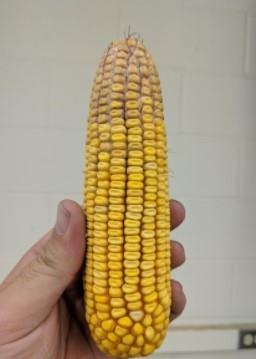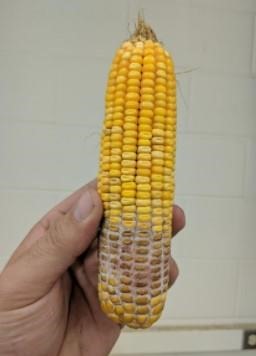By Pierce Paul and Wanderson B. Moraes et.al
After walking more than 40 corn fields and sampling more than 3,500 ears, we believe that Gibberella ear rot (GER), and consequently, vomitoxin levels likely will be much lower this year than they were last fall. This is because conditions during the weeks after silking were considerably less favorable for the disease to develop and the toxin to contaminate grain this year than last year. However, as is often the case, there were a few exceptions. We found low levels of GER in (sentinel-type) plots and research fields deliberately planted with hybrids that are highly susceptible to the disease, and these plots/fields will likely yield grain with some level of vomitoxin contamination (we are still processing our samples). Averaged across 10 locations, the incidence of GER on a susceptible hybrid ranged from 10 to 20%, i.e., 1 to 2 out of every 10 ears had visual symptoms of GER, and on average, less than 5% of the surface area of affected ears showed symptoms of the disease.
GER tends to be most severe, and the crop is usually as greater risk for vomitoxin contamination, when infections occur early (during silking), before the ears mature and grain dries down, and conditions are warm and wet during the first three weeks after silking. However, it is not uncommon for grain to become contaminated with vomitoxin as a result of infections occurring late in the season. This is particularly true when harvest is delayed by frequent rainfall, hybrids are susceptible, and ears dry-down in an upright position. Water collects at the base of upright ears, creating conditions suitable for the fungus to enter and infect the ear from the base upwards.
It is not always possible to tell which fields were planted with GER susceptible hybrids, because this information is not readily available in all seed catalogs. However, it should be noted that no hybrid is 100% resistant or immune to GER. As a result, all fields that have not been harvested and have been exposed to rain over the last several days are at risk for Gibberella and other ear rots (including Trichoderma) and grain contamination with mycotoxins. Peel back the husk and examine about 10 ears in each of 8 to 10 sections (approximately 50-ft-long stretches of rows) spread out across the field for symptoms of GER either at the tip or at the base of the ear (see pictures). This will give you an idea of whether your field is affected by GER and vomitoxin will likely be a concern. Where possible, handle and store grain from severely affected fields separately from grain harvested from healthier fields (fields harvested before the rains with little or no GER).

Fig 1. Gibberella ear rot developing from the tip down

Fig 2. Gibberella ear rot developing from the base up
Source : osu.edu